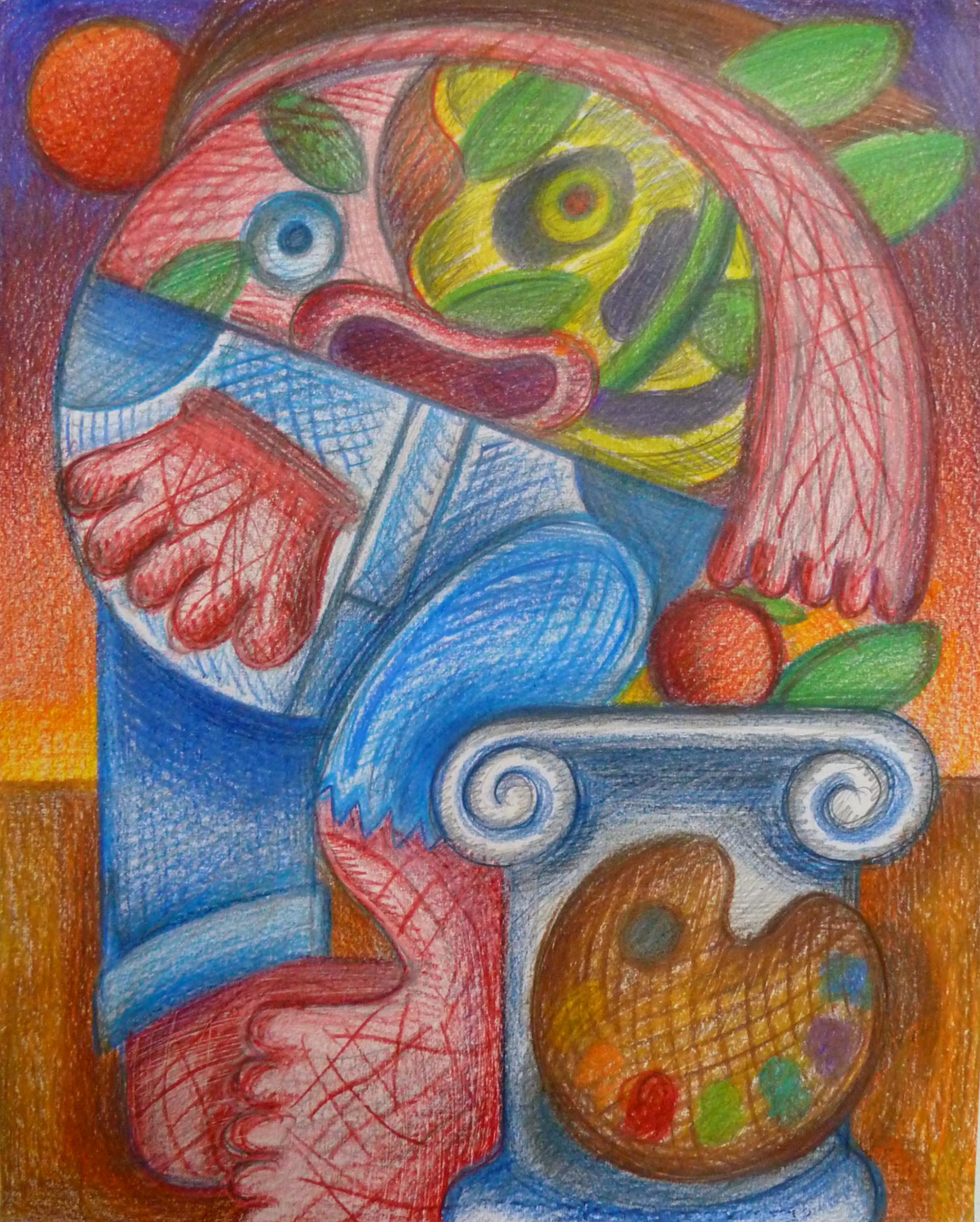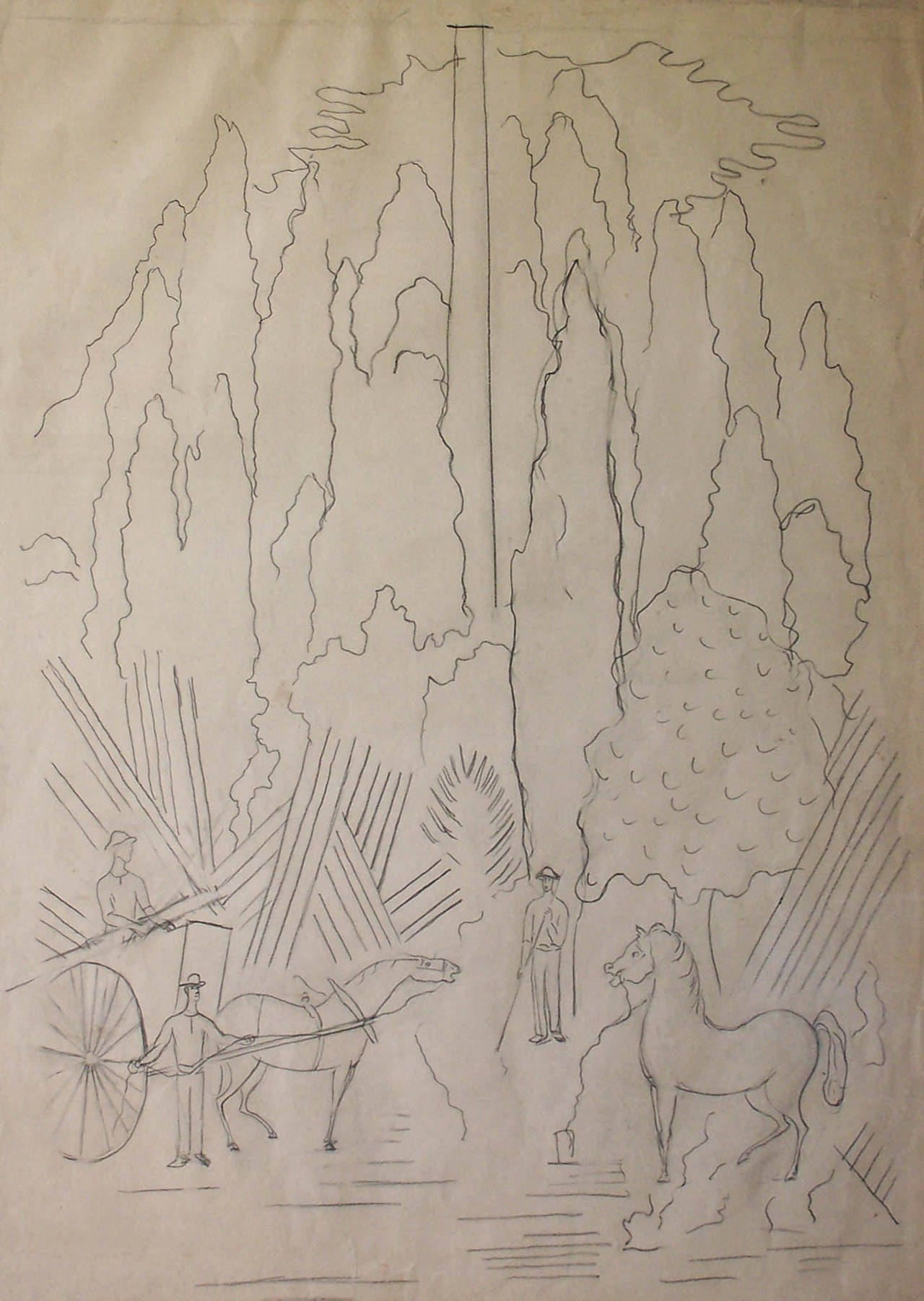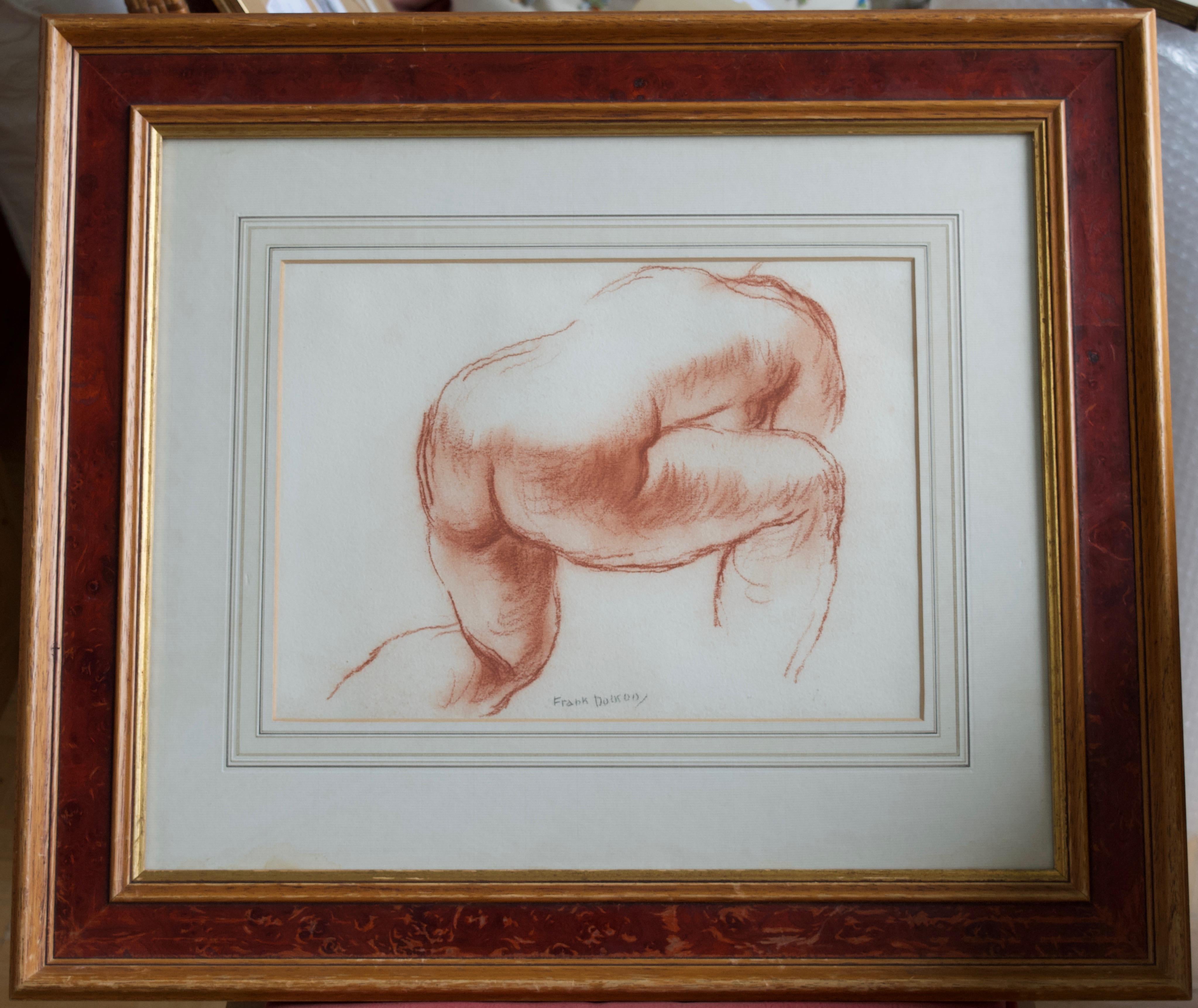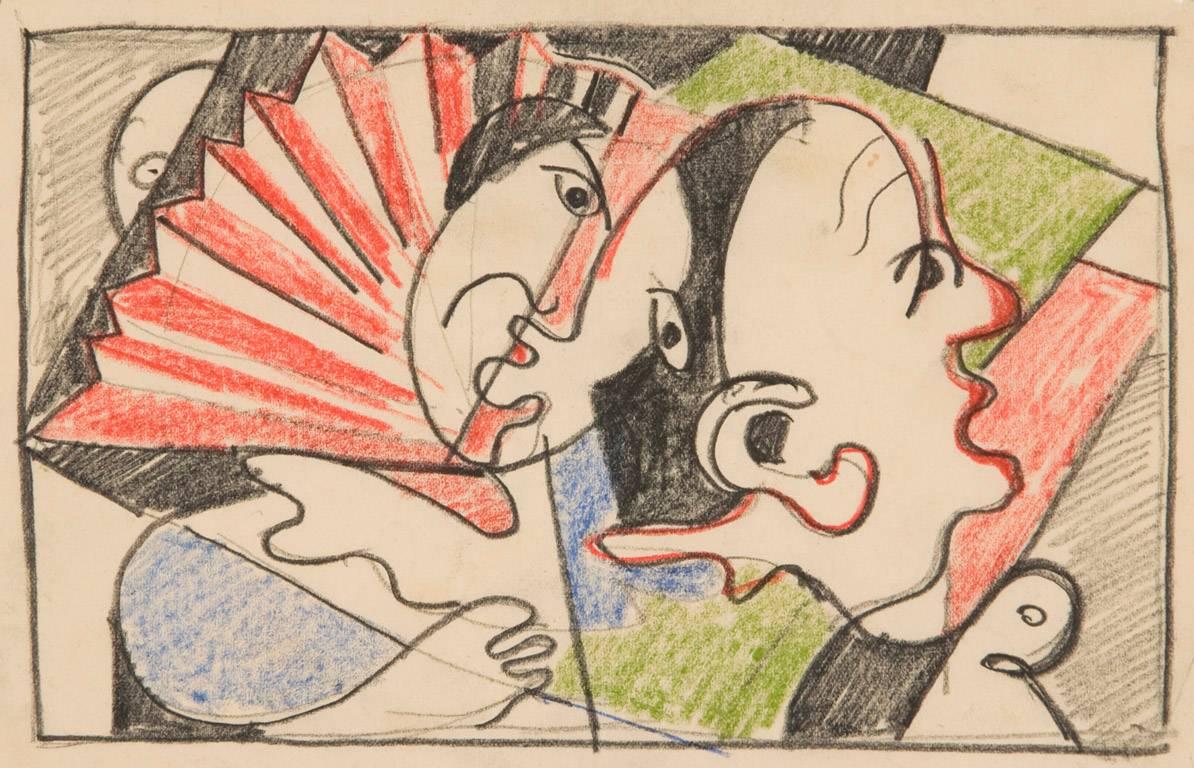Items Similar to 1931 French drawing by Cubist artist Leopold Survage of dancers
Want more images or videos?
Request additional images or videos from the seller
1 of 8
Leopold Survage 1931 French drawing by Cubist artist Leopold Survage of dancers1931
1931
About the Item
Leopold Survage (French / Finnish 1879- 1968)
Les danseuses
Signed and dated ‘Survage / 31’ (lower right)
Pencil on paper
10.1/2 x 8.5/8 in. (27 x 22.2 cm.)
Having risen to the status of a Modern Master as a member of the Cubist group at the beginning of the century, Survage was acclaimed by Apollinaire and Léonce Rosenberg for his idiosyncratic style. Born in Moscow in 1879, as a child he dreamt about becoming an architect but seeing the works of Gauguin and Cézanne in the Morosov collection made him decide to pursue painting and he enrolled at the Moscow College where he met Archipenko, Larionov, Pevsner and Sudeikin. They joined together and exhibited as the Symbolist Group The Blue Rose in 1905. By 1908 Survage was in Paris where he attended Matisse’s course for a short while and exhibited at the Salon d’Automne. After an early Fauvist phase he joined the Cubists while the movement was just developing, he took an active part in their experiments and exhibited with them at the Salon des Indépendants in 1911. In 1910 and 1911 Survage exhibited with the historic Knave of Diamonds society in Moscow that included Kandinsky, Chagall and Malevich, and was one of the most influential organisations for promoting contemporary art and as such considered to be a crucial reference point in the extraordinary adventure of Russian Modernism. In 1912 Survage started on a groundbreaking series “Rythmes Colorés” for which he produced two hundred totally abstract compositions, thus historically positioning himself as one of the early pioneers of Abstract art, many of these are now in the collection of the Museum of Modern Art in New York.
Survage’s contribution to the 1914 Salon des Indépendants was applauded by the famous poet and critic Guillaume Apollinaire, who subsequently organised a one-man exhibition for him in 1917 at the Galerie Bougard. It was during these years that Survage embarked on one of his most famous and influential series, the Cubistic city scenes “Paysages Cubistes”. In 1919 Survage became highly active with the legendary Séction d’ Or group to which he had been a founding member and consisted of all the modern masters, Archipenko, Braque, Boccioni, Gris, Leger, Picasso, Van Doesburg etc. Together they held revolutionary exhibitions in Paris, Rotterdam, Amsterdam, Brussels, Rome. At this time Survage also began to exhibit at the famous Galerie L’Effort Moderne of Léonce Rosenberg who had taken over from Kahnweiler as the leading Cubist dealer. Here during the 1920’s Survage exhibited in several major exhibitions such as “L’Effort Moderne”; “Les Maitres du Cubisme”; “Synthèse et Construction”. Furthermore Survage became involved with the activities of De Stijl and created a series of works for the Bauhaus.
Several international exhibitions over the next few years established Survage’s status as a modern master, most notably Knoedler Gallery, New York, 1929; Painting in Paris, MOMA New York, 1930; Avant-Garde Artists, Tokyo, 1933. His work was becoming increasingly Surreal, drawing inspiration from ancient philosophies, his visionary goal was to interpret in understandable signs and images the profound realities of life, often influenced by the “Arcana Caelestia” writings of the 18th century Swedish scientist and mystic Emanuel Swedenborg.
Survage's reputation would continue to be reinforced through numerous exhibitions over the next few decades of the artist’s prestigious career including Abstract Art, the First Masters, Paris, Rome, Milan, 1950. In 1937 he received the coveted gold medal for his outstanding work at the Paris International Exhibition. His immense contribution to the development of modern art has been recognised through several awards notably the Prix National Français de la Solomon Guggenheim Fondation, 1960; and the Légion d’Honneur, 1963; also many retrospectives including a major show in 1966 that started in Paris and went on tour to international museums.
The artist is represented in many public collections including the Musée National d’Art Moderne, Centre Georges Pompidou Paris; Tretyakov Gallery, Moscow; Musée du Petit Palais, Geneva; National Gallery, Prague; Athens Museum; Wallraf Richartz Museum, Cologne; Chicago Arts Club; Bezalel Museum Jerusalem; Minneapolis Institute of Arts; San Francisco Museum of Modern Art; Museum of Modern Art, New York.
- Creator:Leopold Survage (1879 - 1968, French, Finnish)
- Creation Year:1931
- Dimensions:Height: 10.5 in (26.67 cm)Width: 8.63 in (21.93 cm)Depth: 1 in (2.54 cm)
- Medium:
- Movement & Style:
- Period:
- Condition:Recently backed by a restorer so that that tear to the lower left is masked (though evident on close inspection). Beautifully framed and mounted behind mask in a black and silver art deco moulding.
- Gallery Location:Petworth, GB
- Reference Number:1stDibs: LU54038387892
About the Seller
4.9
Platinum Seller
These expertly vetted sellers are 1stDibs' most experienced sellers and are rated highest by our customers.
Established in 2010
1stDibs seller since 2017
230 sales on 1stDibs
Typical response time: 2 hours
- ShippingRetrieving quote...Ships From: Petworth, United Kingdom
- Return PolicyA return for this item may be initiated within 10 days of delivery.
More From This SellerView All
- 20th Century watercolour of Turkish ladies at the baths in IstanbulBy Vladimir Pavlovich NechoumoffLocated in Petworth, West SussexVladimir Pavlovich Nechoumoff (Russian, c. 1900 – 1977) Turkish bath scene in Istanbul Watercolour/ gouache and pencil on paper 5.1/2 x 8.1/2 in. (14 x 21.4...Category
20th Century Art Deco Figurative Drawings and Watercolors
MaterialsPaper, Pencil, Gouache, Watercolor
- Russian, early 20th Century watercolour of Turkish fruit sellersBy Vladimir Pavlovich NechoumoffLocated in Petworth, West SussexVladimir Pavlovich Nechoumoff (Russian, c. 1900 – 1977) Turkish fruit sellers, Istanbul Pencil and watercolour on paper 9 x 13.5/8 in. (22.8 x 34.5 cm.) Figurative painter, illustra...Category
Early 20th Century Art Deco Figurative Drawings and Watercolors
MaterialsWatercolor, Pencil, Paper
- Russian, Art Deco drawing of a lady of springtime, early 20th CenturyBy Vladimir Pavlovich NechoumoffLocated in Petworth, West SussexVladimir Pavlovich Nechoumoff (Russian, c. 1900 – 1977) The maiden of spring Pencil on paper Signed and dated ‘V. Nechoumov / 1921’ (lower right) 8.1/4 x 8 in. (21 x 20 cm.) Figu...Category
Early 20th Century Art Deco Figurative Drawings and Watercolors
MaterialsPencil, Paper
- Russian, 20th Century Art deco drawing of a Turkish warriorBy Vladimir Pavlovich NechoumoffLocated in Petworth, West SussexVladimir Pavlovich Nechoumoff (Russian, c. 1900 – 1977) Study of a Turkish warrior pencil on paper signed and dated ‘V Nechoumov, 1921’ (lower left) 8 x 8 in. (20.3 x 20.3 cm.) Fig...Category
Early 20th Century Art Deco Figurative Drawings and Watercolors
MaterialsPencil, Paper
- 18th Century Italian head study of a Roman maidenLocated in Petworth, West SussexAttributed to Giovanni Battista Cipriani (Italian, 1727 – 1785) A head study of a Roman maiden Sanguine, pencil and pastel on paper 7.1/2 x 5.7/8 in. (19 x 14.8 cm.)Category
18th Century Academic Figurative Drawings and Watercolors
MaterialsPastel, Paper, Pencil
- French 20th Century drawing of figures on an orientalist rooftop by JossoLocated in Petworth, West SussexCamille Paul Josso (French, 1902 – 1986) Figures on an orientalist rooftop Signed, inscribed and dated ‘CP JOSSO CHARDON / SALE.10-7-27. (lower right) Pencil, black crayon and waterc...Category
20th Century Other Art Style Figurative Drawings and Watercolors
MaterialsPaper, Pencil, Watercolor, Crayon
You May Also Like
- TwinsBy Miette BraiveLocated in West Hollywood, CABelgian artist Miette Braive(1916-2000), was classically trained in Belgium, before moving to Paris to pursue her art career as first a student and then a contemporary of the French ...Category
1940s Cubist Figurative Drawings and Watercolors
MaterialsPaper, Graphite
- "Fading Light", pencil, paper, portrait, cubist, classic arts, vanitasLocated in Toronto, Ontario"Fading Light" is pencil on paper measuring 12" tall by 9" wide. It's very sound structurally, with a figure composed against a classic pedestal (scrolls suggest a Greek Ionic column...Category
21st Century and Contemporary Cubist Portrait Drawings and Watercolors
MaterialsPencil, Paper
- Sketch for Frescoed Frieze - Pencil and Gouache by Paul Bony - 1932By Paul Henry BonyLocated in Roma, ITSketch for Frescoed Frieze is an interesting preparatory study realized by the artist Paul Bony, a famous French painter active in the last century. The artwork is in good state of p...Category
1930s Cubist Figurative Drawings and Watercolors
MaterialsPencil, Gouache
- Study for Batavia (The Woodcutters)By Serge Ferat (Sergei Nicolaevitch Comte de Jastrebtsov)Located in London, GBSERGE FERAT 1881-1958 (Le Comte Sergueï Yastrebzov) Moscow 1881-1958 Paris (Russian/French) Title: Study for Batavia (The Woodcutters), circa 1926 Technique: Original Pencil D...Category
1920s Cubist Figurative Drawings and Watercolors
MaterialsPencil
- Frank Dobson, Study of a nude, sanguine chalkBy Frank DobsonLocated in Harkstead, GBFrank Dobson (1888-1963) Study of a nude viewed from behind Signed Sanguine chalk on paper 10 x 13½ inches 21¼ x 24¼ inches with frame A wonderful exam...Category
Mid-20th Century Cubist Nude Drawings and Watercolors
MaterialsPaper, Chalk
- UntitledBy Edmund Daniel KinzingerLocated in Dallas, TXEdmund D. Kinzinger was born in 1888, to an upper-middle class family in Pforzhein, Germany. In Munich he studied at the Kirr Schule and the Staatliche Akademie, and pursued graduate studies at the Academie Modern, Paris. Before serving in the German Army, Kinzinger was a master student of Adolph Holzel at the Staatcliche Akademie, Stuttgart; he returned to study under Henrich Waldschmidt after nearly five years of artillery service. Several of Kinzinger’s fellow students in Germany, such as Johannes Itten, would go on to be associated with the Bauhaus school. Coming into contact with all manner of artistic influences in Europe after World War One, Kinzinger’s work may be viewed as a “synthesis” of modernist styles. The influences of Abstract Expressionist, Cubist, and Futurist styles in Kinzinger’s work at this time are symptomatic of his contact with the likes of Hans Hofmann, Pablo Picasso, and Alexander Archipenko. Philip Van Keuren...Category
1930s Cubist Abstract Drawings and Watercolors
MaterialsConté, Crayon, Paper





